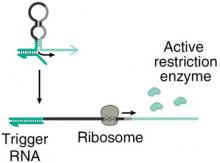BACKGROUND
Point-of-care (POC) testing involves the rapid detection of analytes near patients and enables quick medical decisions that can improve disease diagnosis, monitoring, and management. Cell free systems have been particularly successful as POC diagnostics by utilizing gene-circuit based sensors outside the physiological constraints of cells, which accelerates the product development cycle and enables easy storage, distribution, and use. However, most demonstrations to date rely on optical reporter proteins which require equipment contained in centralized labs and which offer limited multiplexing capabilities. To overcome these limitations, researchers at the University of Toronto have developed a direct gene-circuit/electrode interface that allows point-of-care detection of RNA.
TECHNOLOGY
Our inventors have demonstrated the use of restriction-enzyme-based reporters for multiplexed electrochemical detection of RNA in cell-free systems (Figure 1). The technology consists of a toe-hold loop containing circuit that selectively expresses a restriction enzyme when triggered by pathogenic (or other) RNA. The restriction enzyme can then catalyze the release of a ssDNA reporter fragment, freeing it to bind to its corresponding partner, which is tethered to an electrode. Such a binding event elicits a differential electrochemical signal that can then be detected. Importantly, identification of several orthogonal restriction enzymes enables the simultaneous detection of up to 10 species. Furthermore, the flexible nature of the system also enables POC readouts beyond the electrochemical realm.
Figure 1. A gene-circuit/electrode interface for cell-free synthetic gene networks. Binding of trigger RNA (green), unravels a toe-hold loop, exposing a ribosome binding site (black) which leads to expression of a particular restriction enzyme. This enzyme can then digest a double stranded DNA molecule (annealed reporter DNA) releasing the contained redox reporter (blue circle). Binding of the redox reporter to corresponding DNA tethered to a microelectrode generates an electrochemical signal which can be detected.
COMPETITIVE ADVANTAGE
- Point-of-care detection
- Low cross-reactivity between restriction enzymes
- Multiplexing (10 orthogonal restriction enzymes identified)
- Fast response time possible (~ 30 min)
- Low limit of detection
- ~ 65 nM (without isothermal amplification)
- ~ 1 fM (with isothermal amplification)
- Potential for automated and high-capacity biosensing
- Low Cost (<US$1 per test)
APPLICATIONS
- Infectious disease detection (e.g. bacteria, viruses)
- RNA detection
- Health, agriculture, national security, industry
INTELLECTUAL PROPERTY STATUS
- PCT Application (Oct 2020)
PROJECT STATUS
Proof-of-concept studies have been conducted. Multiplexing capabilities were demonstrated through identification and use of 10 orthogonal enzymes, each with high rates of expression and processivity. Sensor detection of RNA was demonstrated using six synthetic model RNA sequences and through detection of colistin antibiotic resistance genes.





